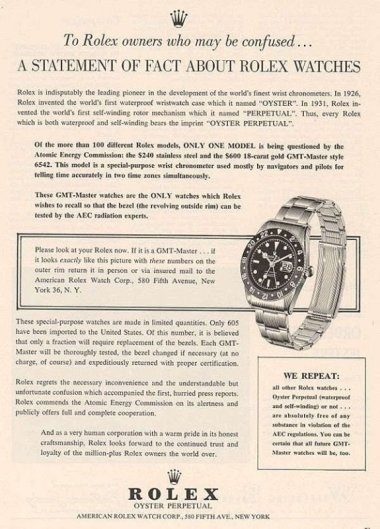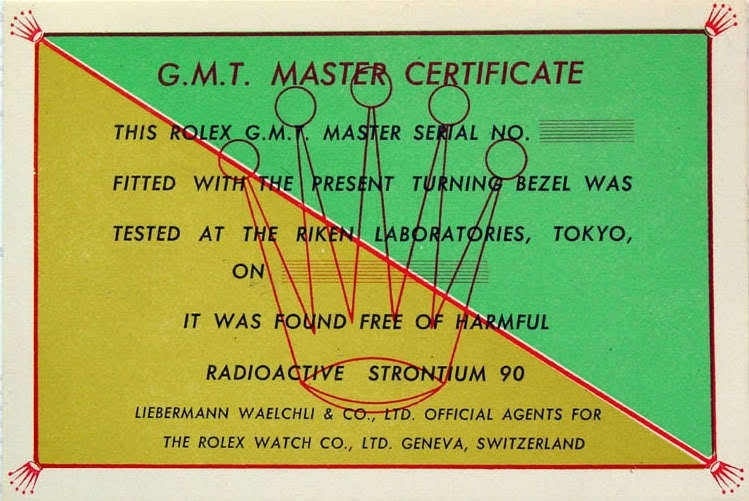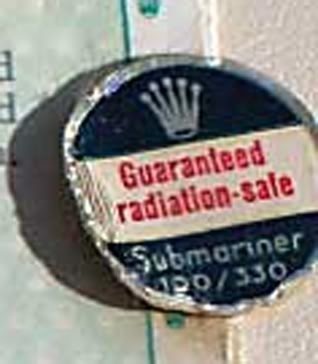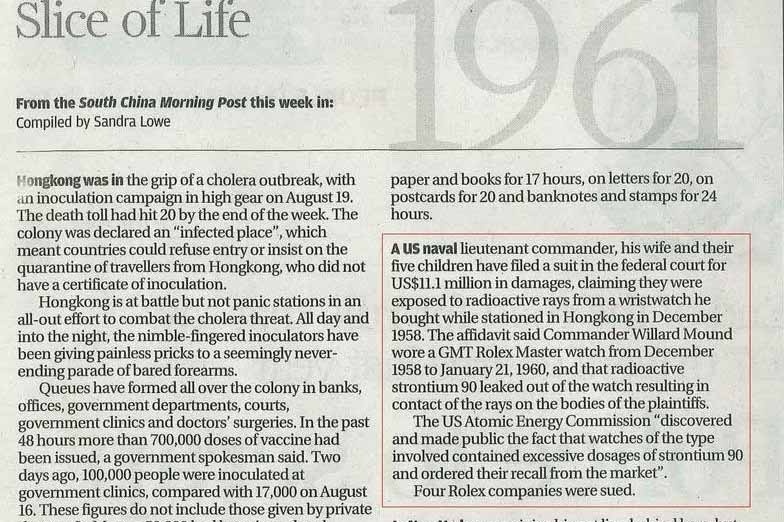
Baron - Mr Red
14613

Rolex and radioactivity
This article is a composite from a number of contributions made on the theme of Rolex and radioactivity. It picks up quotes and thoughts from a number of different people. It also includes both parts of Marcello’s article on the issue written some 10yr or more ago.
We all know that, once upon a time, radium used to be used on lume. Back in the 1950s, believe it or not, radium water was actively marketed as a health-giving drink. Likewise, radium toothpaste was also widely on sale as giving one's teeth that extra "glow". It was one of the ingredients in certain types of chocolate and many other consumable products. It was of course also used on lumes in watches. One of the practices that the workers who conducted that particular work commonly adopted in order to get a very good finish on the lume was for the tip of the paint brush that had radium on it to be placed in the mouth so that it was compressed and aligned so that a neat finish could be applied to the watch dial.
Many of these workers subsequently died of various forms of cancer as the radium quite often dissolved the bones in their mouths. Direct contact with radium is not a good thing. Is it dangerous on a watch lume? This is a question that has been looked at by a number of people. I know I have taken each of my watches to a physics professor i know and had the radiation levels tested. So often, a simple Geiger-counter test is not enough to determine if something is dangerous or not. Of course, if a reading is off the scale, it would be a worry. The half-life of radium is certainly long enough to keep it active for a very long period, though it would depend on what isotope was being examined. Suffice to say, Rolex were wary enough of it to make a shift to tritium. When i tested my watches, those with radium recorded well above background noise but actually not anywhere near levels that are seen as dangerous. Further, if the readings were taken through the case back, then most if not all the effect was nullified. So, unless you go to sleep with your head on the front of the watch, it is basically just not an issue..
Tritium was the next lume of choice by Rolex. For the record, not one of my watches with tritium is now recording above-noise levels of radiation. The half-life is pretty short.
But it is not tritium that i find interesting, it is the debate about strontium, the shift from radium to tritium (and the so-called exclamation point that has appeared on so many Rolexes around the period 1961-1963) and exactly what this all meant. First things first...it would be great to put to bed the idea that Rolex just did not use Strontium on their watches. Strontium is most definitely not a nice radioactive buddy to have. It can cause serious health problems and as it breaks down, it turns into something with an even longer half-life. Basically, as far as I can understand, strontium potentially gets more radioactive the longer it is around and its characteristics are not pleasant. So....did Rolex really jump from Radium to Strontium to Tritium...... what happened? Thanks to Nicolas for the following scans - an interesting starter…


So, on the basis of these two pieces of information, what conclusions can i draw? Well, I think drawing a conclusion would be premature. What appears a reasonable assumption, then?
1) Rolex did use strontium on some watches.
2) The strontium used was applied to the bezel and not the dial.
3) The strontium was used on a very small batch of watches restricted to early GMTs
4) No other Rolex reference had the strontium issue.
5) If the strontium issue was related to just the GMT, is it reasonable to assume that the so-called exclamation mark that appears across a number of references, notably Submariners, has absolutely nothing to do with strontium.
6) Or could it be that, in order to dispel concern, the exclamation mark was applied in order to confirm to the buying public that no dangerous radioactive material was present?
From Teofft
“I’m somewhat of a radiation expert, and have always wanted to own a 6542 for my personal testing. Technically, if we knew in general what the activity of the original paint was, i could measure the current activity quite simply and date the watch! It would certainly clear up in my mind any questions of authenticity. Radium emits mostly alpha particles and b/c in general alpha particles are "fat" and "slow" something as thin as a piece of paper and certainly the plexi on watches would prevent harmful exposure. however, ingestion or inhalation would be very harmful and could cause major dna damage via ionizing radiation. Strontium likewise has been shown to cause leukemias.
Both radium and strontium are calcium homologues and can track deposition of calcium (ie go to bone). Unlike radium, strontium emits beta particles, which again is a type of ionizing radiation, but as opposed to alpha radiation that can be stopped with paper, you'll need an aluminum plate. Gamma radiation used to treat cancer needs lead! From what i understand about these isotopes, in their native form, exposure to air or water causes the color to turn black or brown....hence the unique patinas seen on watches of this era.”
From Nicolas
"Only 605 6542s were imported to the U.S ". This document is dated from December '59. So, at the end of the 6542 production.
It is a personal guess that the U.S were an important market for Rolex. Maybe the most important.I don't know how many were imported to the rest of the world, but this information about how many 6542 were imported to the U.S lead me to think that this reference was far from being massively produced, and quite rare.
Back to your main question, now:In 1961, if I remember well ( I worked on that topic, but I still have to find where I've posted it ) the international reglementation about radioactive luminous material gave up with radium to go for tritium.
Was it immediately effective? Certainly not, but the T Swiss < 25 started to pop on our Rolexes in 1963.”
Did Rolex changed for tritium before? That is a good question!
From Marcello
Here is the part 1 of a work written by me around 2000 for the Italian magazine " Orologi & Market " ( at that time owned by Pucci ).
Part 1
The need to read time even under inadequate conditions or in the dark was first felt during the first decades of the last century, with the development of military watches (essentially wrist watches), which had to guarantee accurate reading along 24 hours. Both hands and indexes had to be provided with luminescent materials, that is to say, capable of emitting visible light, meaning that their wave length had to be included in a range between 690 and 400 nanometers, corresponding to a band width between dark red and dark violet. Light emission, however, requires for sources of energy (included between 40 and 80 kilocalories per volume of material), which can be either external (heat) or radiating. In other words, luminescence requires for “exciting” substances emitting continuous radiations and for a *”scintillator”, that is to say a phosphorescent material emitting light as long as possible at the end of each excitation. “Phosphors” are materials capable of emitting light uninterruptedly (a phenomenon called *afterglow”) even when the radiation has ceased for a variable period of time - from a millisecond to several days or even years, according to their chemical composition or other “secondary ” conditions. *Fluorescent” materials, instead, emit light spontaneously for about one hundred-millionth of a second at the end of each excitation. These differences in “attitude” can be explained as follows: in both cases, light emission is the result of an external excitation transferred to the electrons present in the material, which pass from a “standard” energy level to a higher level; once this state of excitation is achieved, two main reactions may occur.
1) In fluorescent materials, the electrons’ initial level of energy is instantaneously restored and light emission is therefore very short (as indicated above);
2) In phosphorescent materials, instead, at the end of excitation an intermediate energy status is immediately restored in electrons. Such phenomenon is called “electron trap”. It is statistically improbable that an electron abandons such a status if no other stresses intervene in the process (meaning that it can also stand this status for a very long period of time): the time spent under the electron trap status is directly proportional to fluorescence that is to say to light emission.
Radium was the first material to be employed as an exciter (from the 10s until the beginning of the 50s): discovered in 1902 and obtained from uranium refining processes, it essentially releases alpha particles (isotope Ra 228), and to a lower degree, beta particles and gamma radiations (isotope Ra 226) during its radioactive decay. As far as its dangerousness is concerned, it is important to note that the penetration capacity of alpha particles is very limited. A simply sheet of paper, in fact, is sufficient to block them. This means that they do not even pass through the skin most external layer and, therefore, not even through the glass or the back of metallic watches. Therefore the penetration capacity of beta particles is also rather limited (for ex. 6mm in the air), meaning that they also have difficulty to pass through the skin most external layer or through the back of metallic watches. It can only be dangerous in case of ingestion or absorption through many skin layers as it happened to workers in the period between the two world wars that entered in contact with uranium by wetting the brush sunk in radioactive paint to polish dials.
3) The penetration capacity of gamma radiations, instead, is very high. It can be measured from the outside by means of a Geiger counter: starting from the “basic" radiation value (that is to say the natural one), which is equal to 200 millirad/year, tests carried out in the United States on several military radium-painted watches of the 40s, have showed that the emission average values are equal to 20 millirad/hour, meaning that the watch owner was absorbing in ten hours the same quantity of radiations as we all naturally absorb in one year.
To this purpose, it is important to note that risks deriving from radiations are generally considered as directly proportional to the amount of radiations absorbed. This depends on:
a) the time of exposition
b) the mass (total quantity) of radiating material
c) the radiation dose emitted within the time unit by the mass unit of the radiating material
d) the natural decay speed.
The aforesaid values are to be considered as limit values: according to other studies, the average dose of emission for a radium watch is 4 millirad/year only, that is to say, one fiftieth of natural dose, equal to an hour emission of 0.0013 millirad/hour (supposing that the owner wears the watch for 3000 hours a year). The second “historical” material (employed for the construction of some military watches as from the 40s) is tritium (H3). It is a little radioactive isotope which only releases beta particles during its decays and transforms into helium (He 3) in % equal to 5.5 a year. This means that, every 12.3 years, it transforms half of its initial quantity and that, in this period of time, it contemporaneously loses half of its radioactivity. The years necessary to reduce 50% of materials radioactivity is defined as “half cycle”: as far as tritium is concerned, such a period of time is very short if compared to that of one of the two components of radium, isotope 226, whose half cycle is equal to 1600 years. Apart from the fact that beta particles are not particularly dangerous, it is important to consider that the level of radiation absorption in metallic tritium-painted watches is inferior to 0.03 millirad a year (in any case, much inferior to radiums radioactivity). Absorption in watches equipped with plastic cases is slightly higher: it can be estimated in the range of one five-hundredth with respect to natural radiation, and therefore, in this case too, the risk is irrelevant. The writing “T<25” stamped on many watches as from the 60s (it is important to remember that a law issued by the American Food and Drug Administration in 1961 allowed for the free marketability of unlicensed tritium-painted watches), means that tritium radioactive emission is inferior to 25 milliCurie. As the Curie is a measure representing the quantity of radioactivity contained in one gram of radium, T<25 means that each gram of tritium present in paint, produces a level of radioactivity inferior than 25:1000 of one gram of radium, that is to say, 40 times less.
Part 2
In the last article we considered that the amount of radiations issued by the tritium contained in a watch it actually very low and that, in any case, it is not harmful to our health.
Watch producers (especially Japanese ones/ front the 70’s on had been searching for a phosphorescent paint that was totally deprived of radioactive emissions and which did not force them combining the scintillator (usually zinc sulphate with metallic additive welt as copper anti silver) with a radioactive substance that could excite it (for ex radium or tritium).
Therefore, it was necessary to find a material that could self-excite and tend out a visible light for (a significant period of time 'a whole night, for instance) and which was capable to repeat the same operation for many years. It was also necessary to take into consideration that the average 'survival' of a mechanical watch should not be inferior to 30 years, that is to say the time span guaranteed by many motions in term of spates supply.
Apart from the sunlight (which is not always available) the simplest and more easily findable source of external excitation was the light of a lamp. So, the phosphorescent paint was to be aide to self-excite with wavelength not inferior than 400 nanometers (that is to say, within a visible light field), and did not have to be bound to particular light sources which, for instance, operated within the infra-red band.
Another problem of this method (called "photoluminescence" - the capacity to issue light as a result of a luminous excitation) was the quality of the light issued by the paint components: once the excitation had stopped, several phosphorus of this type (that is to say, photosensitive) produced a very brilliant light which, however, exhausted too quietly: other phosphorus instead were much more resistant but the light they produced was not usable because it was too pale. In other words, the material used was to have both mechanical (resistance) and optical qualities (quality and duration of the light issued) not inferior than those of tritium paints, which, instead were very efficient but unfortunately, very expensive too.
These problems could be avoided by using paints with tritium. Tritium paint in fact, are provided with an internal source of energy (natural decay of the radioactive materials), the scintillator is constantly excited and so, even if its brightness loses rapidly, it succeeds producing light without decreasing its emission capacity instead, there were other variables that needed to be taken into consideration when using this paint which is to say:
1 the density (and, therefore, the thickness) of tire luminescent component (an excessively thick or dense layer tended to reduce the efficiency of the emission as the light was self-absorbed).
2 the choice of metallic additives (to produce light that has a specific colour nuance).
Obviously, even the paint with tritium can be excited in ultra-violet rays (sunlight) or by other light sources but. in this case the light emission is limited over time (a couple of hours, for instance), as it happen with epoch watches when tritium exhausts and loses its capacity to excite luminescent material: in this connection, it is important to remind that the natural decay of tritium starts immediately after in production, and that its working life starts before the paint is actually applied on the dial. Considering that the research carried out to find a valid alternative to tritium started only after the first oil shock (beginning of the 70s), it is easy to understand how the necessity to reduce the production costs was actually the main reason of the change.
At the beginning of the 90s, Luminova was finally introduced on the market by the Japanese company, Nemoto. The product was an immediate success. first of all with quartz watches produced in Japan (it was fundamental to reduce the cost of dials) and, successively with mechanical watches Rolex, in fact, abandoned tritium paint) at the beginning of 1999 and started to adopt this new product.
The chemical composition of Luminova is essentially based on an oxidized compound of aluminum and strontium (SR-A12-04), with the following characteristics:
A) Sensitiveness to light sources with wavelengths in the range of 200 and 400 nanometers (identical to that of paints with 'classical' scintillator, that is to zinc/copper sulphate);
B) Light emission with maximal wavelength (pick) analogous to that of "classical 'paints, (that is to say, about 500 nanometers);
C) Residual brightness calculated 10 minutes after every excitation 10 times higher than that of "classical paints;
D) Brightness duration longer than 30 hours after every excitation, that is to say 10 times higher
E) At least 15 hours of clear visibility after every excitation.
This comparison is in favor of Luminova. but it is necessary, to underline that classical paint based on zinc/copper sulphate were created to operate with continuous light source of excitation, and that the necessity of an external stress began only after twenty years.
In addition, no one could foresee that, only a few time later, the regulations of several countries (Europe in the forefront) would ban the employment of tritium as a result of an indiscriminate hunt of every radioactive emission, however insignificant and harmless it was.
Bill (citing Tomvox1 - VRF)
"The story behind the 6536/1 with III-57 caseback and 306.xxx serial is that the owner read an article in the Dutch newspaper by Schaap & Citroen jewelers asking owners of submariner to come back and change it to a less active / radioactive dial version. There where a total of 9 around. This was in the Netherlands around 1960, i have the signed receipt of schaap & citroen...during changing the dial to a lower radiated now 2 colour gilt dial, he got changed the winding crown too, old one is on receipt.."
So we have a semi-official recall of Submariners (not just GMTs) ca. 1960 and the swapping of dials to a demonstrably less radioactive version (the Geiger doesn't lie and the jewelers admitted the motivation, after all).
Now add in these newly recognized T SWISS T 6610 dials and this would strongly indicate that Rolex subsequently issued a standing order to swap these earliest "high radiation" Tool watch dials with newer "safe radiation" versions whenever they might come in for service. Because these 6610 dials are marked with the anomalous "T SWISS T" (which no other Tool watch dial was ever marked until the 1655) we can conclude that these dials were specifically manufactured and kept in stock in the 1960s for such replacements after the Tritium agreements of 1962.
One might also make the leap that the "first replacement" 2-color dials noted by Philipp in the case of the 6536/1 which was recalled in the Netherlands probably contains not much more radioactivity than those dials that would be marked "SWISS T-25" just a few years later. That is to say, that as part of their response to the Strontium 90 scare of 1958-59, Rolex had already moved to greatly reduce the radioactive content of their luminous material well before the international mandate for T for Tritium markings by finding another, less dangerous super luminous compound for their Tool models (most likely Tritium activated phosphors). This is probably also why Rolex felt confident in issuing this sticker to accompany their next generation of Tool watch dials prior to the T for Tritium era:

Which is to say that, precise meanings of the Underline and Ex Point aside, from the very start the Dutch Boys have been on to the correct chronology of Rolex's switch away from the highly radioactive luminous material used on the very first Submariners, Explorers, GMTs, Milgauss and Turn-O-Graphs (probably Strontium 90-based). And after the S-90 scare of 1958-9, all of these particular models most likely received the standing order from Rolex that whenever they should come in for service a "radiation safe" dial should be installed, whether that be in the immediate years after the scare or decades later. Perhaps this explains the many different generations of replacement dials for non-crown guards Tool models: different replacement dials manufactured in different eras to different standards but still needing to be manufactured to fulfil Rolex's standing orders and their objective of eradicating these original, highly radioactive dials.
And from Nicolas....another brick in the wall for the Strontium theorists

This message has been edited by Baron on 2013-12-14 09:07:20




